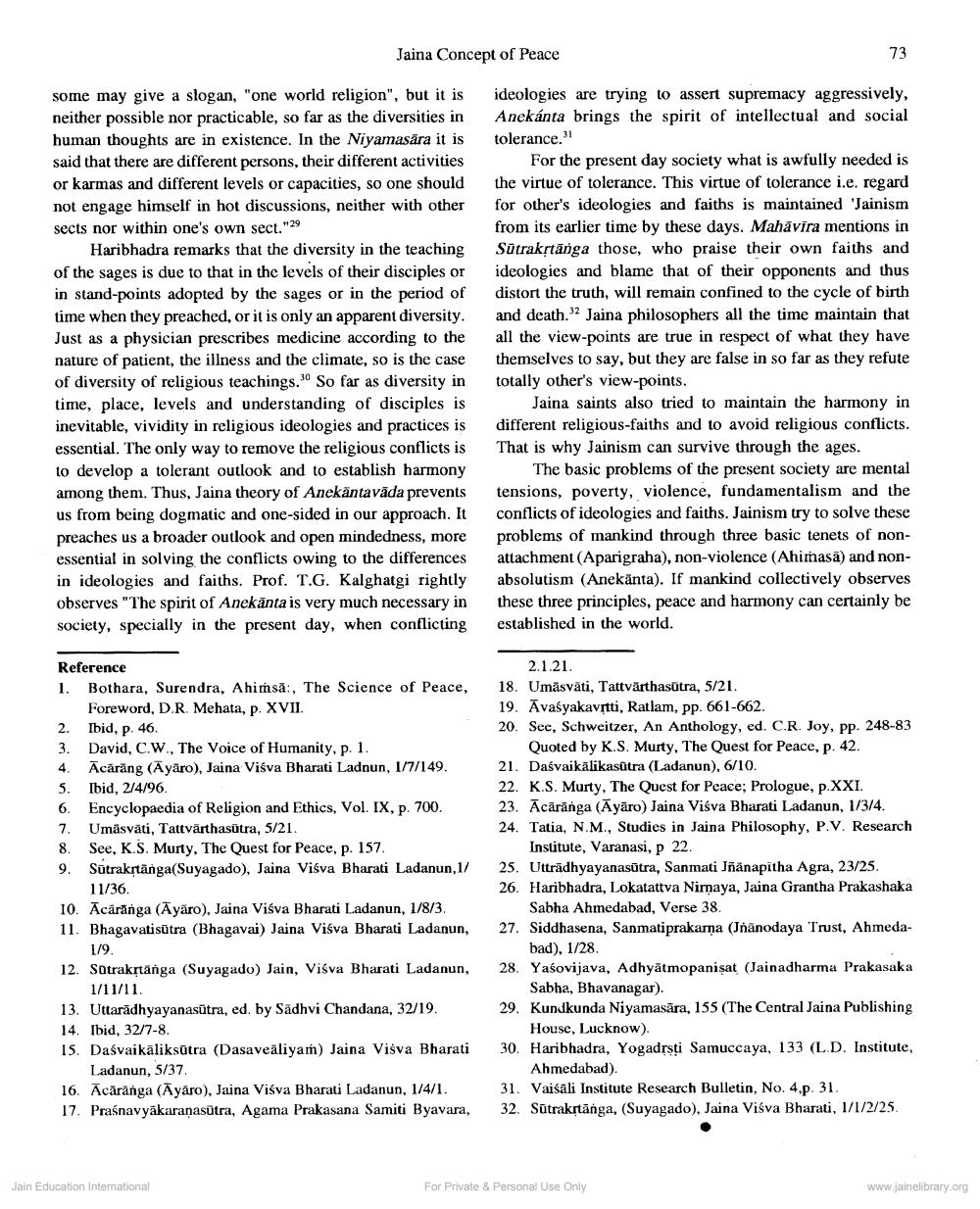Book Title: Jaina Concept Of Peace Author(s): Sagarmal Jain Publisher: Z_Jaina_Literature_and_Philosophy_a_Critical_Approach_001936_HR.pdf View full book textPage 8
________________ Jaina Concept of Peace 73 some may give a slogan, "one world religion", but it is neither possible nor practicable, so far as the diversities in human thoughts are in existence. In the Niyamasara it is said that there are different persons, their different activities or karmas and different levels or capacities, so one should not engage himself in hot discussions, neither with other sects nor within one's own sect."29 Haribhadra remarks that the diversity in the teaching of the sages is due to that in the levels of their disciples or in stand-points adopted by the sages or in the period of time when they preached, or it is only an apparent diversity Just as a physician prescribes medicine according to the nature of patient, the illness and the climate, so is the case of diversity of religious teachings. 30 So far as diversity in time, place, levels and understanding of disciples is inevitable, vividity in religious ideologies and practices is essential. The only way to remove the religious conflicts is to develop a tolerant outlook and to establish harmony among them. Thus, Jaina theory of Anekantavada prevents us from being dogmatic and one-sided in our approach, It preaches us a broader outlook and open mindedness, more essential in solving the conflicts owing to the differences in ideologies and faiths. Prof. T.G. Kalghatgi rightly observes "The spirit of Anekanta is very much necessary in society, specially in the present day, when conflicting ideologies are trying to assert supremacy aggressively, Anekanta brings the spirit of intellectual and social tolerance. 31 For the present day society what is awfully needed is the virtue of tolerance. This virtue of tolerance i.e. regard for other's ideologies and faiths is maintained 'Jainism from its earlier time by these days. Mahavira mentions in Sutrakstanga those, who praise their own faiths and ideologies and blame that of their opponents and thus distort the truth, will remain confined to the cycle of birth and death.32 Jaina philosophers all the time maintain that all the view-points are true in respect of what they have themselves to say, but they are false in so far as they refute totally other's view-points. Jaina saints also tried to maintain the harmony in different religious-faiths and to avoid religious conflicts. That is why Jainism can survive through the ages. The basic problems of the present society are mental tensions, poverty, violence, fundamentalism and the conflicts of ideologies and faiths. Jainism try to solve these problems of mankind through three basic tenets of nonattachment (Aparigraha), non-violence (Ahimasa) and nonabsolutism (Anekanta). If mankind collectively observes these three principles, peace and harmony can certainly be established in the world. Reference 1. Bothara, Surendra, Ahimsa:, The Science of Peace, Foreword, D.R. Mehata, p. XVII. 2. Ibid, p. 46. 3. David, C.W., The Voice of Humanity, p. 1. 4. Acarang (Ayaro), Jaina Visva Bharati Ladnun, 1/7/149. 5. Ibid, 2/4/96. . 6. Encyclopaedia of Religion and Ethics, Vol. IX, p. 700. 7. Umasvati, Tattvarthasutra, 5/21. 8. See, K.S. Murty, The Quest for Peace, p. 157. 9. Sutrakrtanga(Suyagado), Jaina Visva Bharati Ladanun, 11 11/36. 10. Acaranga (Ayaro), Jaina Visva Bharati Ladanun, 1/8/3. 11. Bhagavatisutra (Bhagavai) Jaina Visva Bharati Ladanun, 1/9 12. Satrakstanga (Suyagado) Jain, Visva Bharati Ladanun, 1/11/11 13. Uttaradhyayanasutra, ed. by Sadhvi Chandana, 32/19. 14. Ibid, 32/7-8. 15. Dasvaikaliksutra (Dasavealiyam) Jaina Visva Bharati Ladanun, 5/37 16. Acaranga (Ayaro), Jaina Visva Bharati Ladanun, 1/4/1. 17. Prasnavyakaranasutra, Agama Prakasana Samiti Byavara, 2.1.21. 18. Umasvati, Tattvarthasutra, 5/21. 19. Avasyakavitti, Ratlam, pp. 661-662. 20. See, Schweitzer, An Anthology, ed. C.R. Joy, pp. 248-83 Quoted by K.S. Murty, The Quest for Peace, p. 42. 21. Dasvaikalikasutra (Ladanun), 6/10. 22. K.S. Murty, The Quest for Peace; Prologue, p.XXI. 23. Acaranga (Ayaro) Jaina Visva Bharati Ladanun, 1/3/4. 24. Tatia, N.M., Studies in Jaina Philosophy, P.V. Research Institute, Varanasi, p 22. 25. Uttradhyayanasutra, Sanmati Jnanapitha Agra, 23/25. 26. Haribhadra, Lokatattva Nirnaya, Jaina Grantha Prakashaka Sabha Ahmedabad, Verse 38. 27. Siddhasena, Sanmatiprakarna (Jnanodaya Trust, Ahmeda bad), 1/28. 28. Yasovijava, Adhyatmopanisat (Jainadharma Prakasaka Sabha, Bhavanagar). 29. Kundkunda Niyamasara, 155 (The Central Jaina Publishing House, Lucknow). 30. Haribhadra, Yogadrsti Samuccaya, 133 (L.D. Institute, Ahmedabad). 31. Vaisali Institute Research Bulletin, No. 4,p. 31. 32. Sutrakrtanga, (Suyagado), Jaina Visva Bharati, 1/1/2/25. Jain Education International For Private & Personal Use Only www.jainelibrary.orgPage Navigation
1 ... 6 7 8
